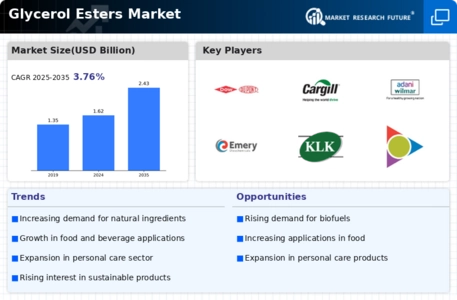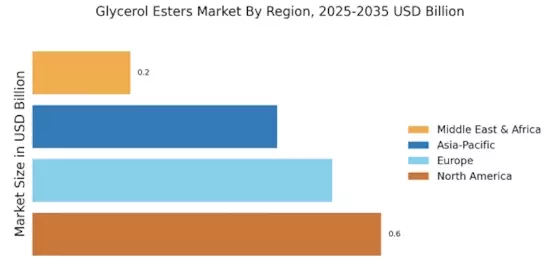Rising Demand for Bio-based Products
The increasing consumer preference for bio-based products is a pivotal driver in the Glycerol Esters Market. As sustainability becomes a focal point for many industries, glycerol esters, derived from renewable sources, are gaining traction. This shift is particularly evident in sectors such as food, cosmetics, and pharmaceuticals, where natural ingredients are increasingly favored. Market data indicates that the demand for bio-based products is projected to grow at a compound annual growth rate of approximately 10% over the next five years. This trend not only reflects changing consumer attitudes but also aligns with regulatory frameworks promoting environmentally friendly alternatives. Consequently, manufacturers in the Glycerol Esters Market are likely to invest in the development of innovative bio-based glycerol esters to meet this rising demand.
Expanding Applications in Food and Beverage
The versatility of glycerol esters is driving their adoption across various applications in the food and beverage sector, significantly impacting the Glycerol Esters Market. These compounds serve as emulsifiers, stabilizers, and texturizers, enhancing the quality and shelf life of food products. Recent market analysis suggests that the food and beverage segment accounts for over 40% of the total glycerol esters consumption. As consumers increasingly seek clean-label products, the demand for natural emulsifiers is expected to rise. This trend is further supported by the growing popularity of plant-based diets, which often require effective emulsification. Therefore, the Glycerol Esters Market is poised for growth as manufacturers adapt to these evolving consumer preferences and regulatory standards.
Regulatory Support for Sustainable Practices
Regulatory frameworks promoting sustainable practices are playing a crucial role in shaping the Glycerol Esters Market. Governments worldwide are implementing policies that encourage the use of renewable resources and environmentally friendly production methods. This regulatory support is particularly evident in the food and cosmetics sectors, where compliance with safety and sustainability standards is paramount. As a result, manufacturers are increasingly turning to glycerol esters as viable alternatives to synthetic additives. Market analysis suggests that regions with stringent regulations are witnessing a faster adoption of glycerol esters, as companies strive to align with these guidelines. Consequently, the Glycerol Esters Market is likely to experience growth driven by regulatory incentives that favor sustainable product offerings.
Growing Interest in Personal Care and Cosmetics
The rising interest in personal care and cosmetic products is emerging as a significant driver for the Glycerol Esters Market. Glycerol esters are widely utilized in formulations for their emollient and emulsifying properties, making them essential ingredients in creams, lotions, and other cosmetic products. Recent market trends indicate that the personal care sector is expected to grow at a rate of 8% annually, with a notable shift towards natural and organic formulations. This trend is largely driven by consumer awareness regarding the safety and efficacy of ingredients used in personal care products. As a result, manufacturers in the Glycerol Esters Market are likely to focus on developing innovative glycerol ester formulations that cater to this growing demand for clean beauty products.
Technological Innovations in Production Processes
Technological advancements in the production of glycerol esters are significantly influencing the Glycerol Esters Market. Innovations such as enzymatic synthesis and supercritical fluid extraction are enhancing the efficiency and sustainability of glycerol ester production. These methods not only reduce waste but also improve the purity and quality of the final products. Market data indicates that companies adopting these technologies can achieve production cost reductions of up to 20%. As a result, manufacturers are likely to invest in research and development to leverage these advancements, thereby increasing their competitive edge. This focus on technology is expected to drive the growth of the Glycerol Esters Market, as producers seek to meet the rising demand for high-quality, sustainable glycerol esters.


















Leave a Comment